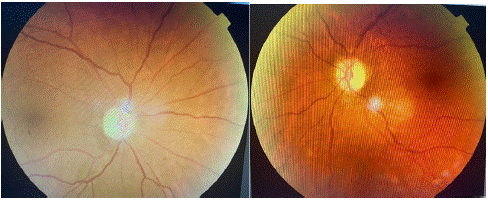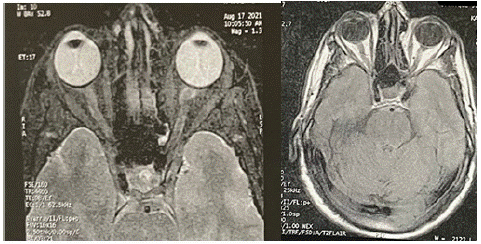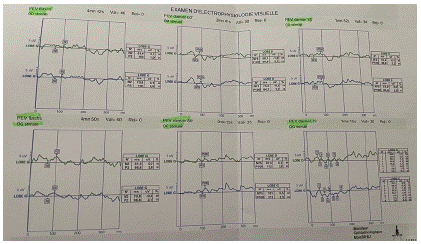Abstract
We propose in this work to report a case of perioperative posterior ischemic optic neuropathy, after a cardiac surgery.
This is a 45-year-old patient, operated for Coronary Angioplasty and Stenting. 24h after the surgery he noticed a bilateral loss of vision.
Examination of the both eyes revealed visual acuity decreased to no light perception, absent pupillary light reflexes and normal fundus. The neurological examinationis normal, macular OCT and cerebral magnetic imaging were normal. Visual evoked potentials were absent confirming the diagnosis of right retrobulbar optic neuropathy.
The evolution was marked by no improvement of vision and the development of optic nerve atrophy. Perioperative posterior ischemic optic neuropathy during cataract surgery is an extremely rare incident.
Posterior ischemic optic neuropathy is an uncommon complication Its physiopathology is multifactorial and dominated by hypotension and anemia. Its prognosis is bad and visual recovery is generally poor.
Keywords: Optic atrophy; Perioperative visual loss; Posterior ischemic optic neuropathy
Introduction
Posterior Ischemic Optic Neuropathy (PION) is an uncommon type of Ischemic Optic Neuropathy (ION) that presents clinically as a retrobulbar optic neuropathy resulting in an initially normal appearing optic disc despite severe visual loss. Its treatment is discussed. The prognosis is reserved.
Purpose
We report the case of perioperative PION, to determine etiopathogenesis, the diagnosis criteria, the treatment and the evolution of this optic neuropathy and to underline the imp-rtance of preventing its occurrence.
Case Report
A 45 year old men presented with acute bilateral and profound visual loss 24 hours after a a Coronary Angioplasty and Stenting Surgery was performed under general anesthesia and lasted 12 hours. The patient was placed in a prone position. The ophtalmic examination revealed decreased visual acuity to no light perception in the both eyes with absent pupillary Light Reflexes. The fundus exam revealed normal optic discs in both eyes.

Figure 1: Fundus imaging showing optic atrophy 1 month after the symptomatology.

Figure 2: Magnetic resonance imaging of the brain and the orbits showing no abnormalities.

Figure 3: Alteration of the Visual Evoked Potential (VEP).
Visual field abnormalities were severe in both eyes. Magnetic resonance imaging of the brain and the orbits and macular OCT were normal. Visuel evoked potentials showed no reliable visual response in both eyes. The electroretinogram showed normal scotopic and photopic responses. One month after the onset of visual loss, there was no clinical improvement. Both optic discs were diffusely pale.
Discussion
PION has been classified into three types: (1) arteritic PION usually due to giant cell arteritis; (2) nonarteritic PION usually due to hypotensive ischemia; and specifically (3) perioperative PION, a form of nonarteritic PION that occurs during or shortly after certain surgical procedures [1]. Thre frequency of occurrence varies from 0.06 to 1% [2]. Bilaterality was found in approximately 2/3 of the case [3]. The diagnostic criteria for PION have been suggested by Buono and Coworkers and are a:
- Acute deficit in visual acuity, visual field or of both,
- An ipsilateral Relative Afferent Pupillary Defect (RAPD) with unilateral disease and sluggish or non-reactive pupils with bilateral symmetric involvement
- Normal optic disc and funduscopic examination at the onset of the visual deficit (This is in contradistinction to anterior ischemic optic neuropathy, where optic disc edema is a requisite for the diagnosis)
- Exclusion of other causes of visual impairment and other causes of optic neuropathy like compression, demyelinating disease, vascular disease and inflammation,
- An alteration of the Visual Evoked Potential (VEP), a normal Electroretinogram (ERG) and
- Optic atrophy 4 to 8 weeks after the start of the symptomatology [5].
Postoperative Ischemic Optic Neuropathy (ION) is a devastating complication that can occur after a variety of procedures including cardiac surgery, spine surgery, head and neck surgery, prostatectomy, liver transplantation, major vascular surgery, liposuction, and other miscellaneous procedures [6]. Posterior ischemic optic neuropathy results from infarction of the intraorbital optic nerve [7].
Perioperative factors such as preoperative anemia and intraoperative hypotension also have been proposed. In addition, recent studies suggest that prolonged operative time in the prone position as well as blood loss (on average, of 45% of estimated blood volume) are associated with an increased risk for developing perioperative visual loss [8].
Purvin suggested that increase in vascular resistance that can be seen in diabetics, hypertensive and obese patient may be associated with PION occurrence [9].
No treatment has proven efficacy, although correction of any underlying hemodynamic disturbance may be beneficial [7].
Arterial hypotension, low hematocrits, and dependent position of the head should be avoided, especially in long cases. In high-risk cases with extreme blood loss, it is prudent to use colloids in proportion to crystalloids to prevent hemodilution [1]. Corticosteroids cannot reverse the risk factors leading to PION. Similarly, antiplatelet medication and intraocular pressure-lowering measures do not address the pathophysiology of PION and are unlikely to be effective [1]. The evolution is towards optic atrophy. The possibilities of visual recovery are poor [9].
Conclusion
Perioperative ischemic optic neuropathy is a rare incident. Its pathogenesis is multifactorial and is dominated by hypotension and anemia. The prognosis remains severe, indeed the chances of visual recovery are poor. Better management of perioperative systemic hypotension and early correction of anemia may allow to decrease the risk of developing PION.
References
- Wang MY, Brewer R, Sadun AA. Posterior ischemic optic neuropathy: Perioperative risk factors. Taiwan J Ophthalmol. 2020; 10: 167-173.
- Nuttall GA, Garrity JA, Dearani JA, Abel MD, Schroder DR, et al: Risk factors for ischemic optic neuropathy after cardiopulmonary bypass : a matched case/control study. Anesth Analg. 2001; 93: 1410-6.
- E Tournaire-Marques. Neuropathies optiques ischémiques. EMC – Ophtalmologie. 2019; 16: 1-9.
- weeney PJ, Breuer AC, Selhorst JB, Waybright EA, Furlan AJ, et al. Ischemic optic neuro pathy: a complication of cardiopulmonary bypass surgery. Neurology. 1982; 32: 560-2.
- Buono LM, Foroozan R, Sergott RC, Savino PJ. Nonarteritic anterior ischemic optic neuropathy. Curr Opin Ophthalmol. 2002; 13: 357-61.
- Lee LA, Newman NJ, Wagner TA, Dettori JR, Dettori NJ. Postoperative ischemic optic neuropathy. Spine (Phila Pa 1976). 2010; 35: S105-16.
- Buono LM, Foroozan R. Perioperative posterior ischemic optic neuropathy: review of the literature. Surv Ophthalmol. 2005; 50: 15-26.
- Stang-Veldhouse KN, Yeu E, Rothenberg DM, Mizen TR. Unusual presentation of perioperative ischemic optic neuropathy following major spine surgery. J Clin Anesth. 2010; 22: 52-5.
- Purvin V. Ischemic Optic Neuropathy. Seminars in cerebrovascular diseases and stroke. 2004.07.002: 18-38).
